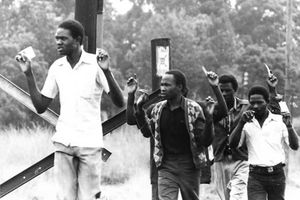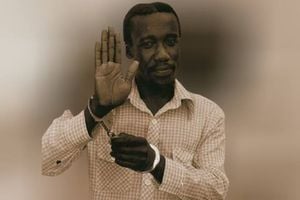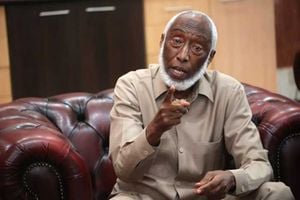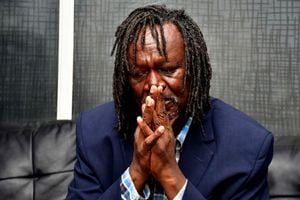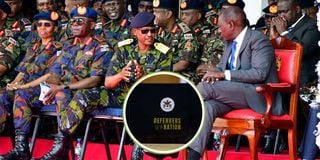
Chief of the Defence Forces (CDF) General Charles Kahariri (right) confers with President William Ruto (second right) during the Kenya Air Force (KAF) 60th Anniversary Celebrations at Moi Air Base on June 08 2024. Inset: The book Defenders of the Nation.
From the fortified walls of Kenya Defence Forces (KDF) installations, where photography by civilians is never allowed, a book rich in photographs and Kenya’s military history has emerged.
President William Ruto, in his foreword, states that Defenders of the Nation is about celebrating KDF’s achievements, which he says are “the result of hard work, sacrifice, and dedication”.
With the book, described by Defence Cabinet Secretary Soipan Tuya as “a window into the military’s world for all Kenyans”, readers can now, for example, have a glimpse of some of the action on that eventful day in September 2012 when KDF executed Operation Sledge Hammer that captured Kismayu from the stranglehold of Al-Shabaab.
Vivid images in the book — which show Kenyan fighters in boats on the calm, blue Indian Ocean waters — offer flashbacks into the operation in which KDF stormed the city through the sea.
Snaps of KDF training activities, food depots, action inside bunkers, special weapons are also provided in a 452-page coffee table book titled Defenders of the Nation.

The book Defenders of the Nation documents the history of the Kenya Defence Forces.
According to Chief of Defence Forces (CDF) Charles Kahariri, the book “provides rare insights into landmark operations, significant incidents, and some of the darkest moments that shaped the KDF into what it is today”.
Through text that accompanies the photographs, readers are given information about battles against the Shifta, Sabaot Land Defence Forces (SLDF), bandits in the North Rift, among others.
And oh, there are the heart-warming bits like the photograph of a KDF couple in uniform with their child. In case you did not know, the book also informs you that it was during the reign of Daudi Tonje as the Chief of General Staff (CGS) that service women were allowed to marry and raise families. It is the same General Tonje, now retired, who allowed women in the military to hold command positions.

Former Chief of General Staff General Mahmoud Mohammed (right) and his successor General Daudi Tonje in this picture taken on September 24, 1996.
Another uplifting image is that of a soldier who lost both legs in the battlefield in Somalia carrying the East African Community flag during a tournament opening event.
Historians will likely scoff at how shallow the book is in terms of providing details of key events involving the military, like the 1982 attempted coup and the 2016 El Adde attack, but the team behind the book believes it is a “significant historical document” that “brings the story of the KDF to life” as stated the acknowledgement sections of the book.
General Kahariri writes in the book’s preface that the book is an attempt at documenting Kenya’s military history.
“No successful strategy can be developed without understanding military history,” he argues. “It is a crucial component of combined military and national security strategies.”
On military history, the book details Sledge Hammer and at least eight other operations the KDF has conducted in and around Kenya.
“This is one of the most notable operations by KDF,” the book says of Sledge Hammer.
“The aim was to capture Kismayu, the de facto Al-Shabaab military and logistical headquarters. Eventually, the port city was captured on Thursday, September 27, 2012, through an amphibious landing. KDF became the first African military to execute a beach-landing operation.”

President William Ruto investitures Chief of Defence Forces General Charles Kahariri with badges of ranks during his swearing-in at State House, Nairobi County.
Other operations detailed in the book include Operation Steel Talon (1997, in the North Rift, targeting banditry); Operation Linda Amani (1998, in North Rift Kenya, also targeting banditry); Operation Fagia Barabara (1999, in Moyale, to flush out the Oromo Liberation Front); Operation Okota Bunduki (2007, in the North Rift, targeting disarmament); Operation Okoa Maisha (2008, in Mt Elgon against the SLDF; and Operation Linda Nchi launched in 2011 against Al-Shabaab in Somalia.
As it chronicles the achievements of Kenya’s five commanders-in-chief to date, the book lists some of the major battles Kenya’s presidents have faced.
For Jomo Kenyatta, some of the threats that required military intervention included the Shifta.
“In November 1963, guerrillas launched major attacks on the Kenyan government installations in the North Eastern region. On December 28, 1963, President Jomo Kenyatta declared a state of emergency in the region,” the book states. “The Shifta conflict lasted from 1963 to 1967…President Kenyatta guided the armed forces in defeating the Shifta secessionists and maintained the sovereignty and territorial integrity of the nation.”
Jomo was also confronted with Uganda claiming a part of Kenya.
“In the mid-1970s, President Idi Amin Dada of Uganda stirred the hornet’s nest when he laid claim to a large part of Kenyan territory. President Amin woke up the lion in President Jomo Kenyatta,” the book indicates, reproducing the founding Head of State’s assurances of a ready military to deal with any insurgence.
Mzee Kenyatta’s successor, Daniel arap Moi, faced upheavals that included the botched 1982 coup, skirmishes on the Kenya-Uganda border in 1987, and a 1999 incident where Somali militias captured military equipment and weapons from a Kenya Army platoon.

General Joseph Kibwana takes his oath after being appointed Kenya’s Chief of General Staff to succeed General Daudi Tonje on November 5, 2000:
Under Mr Moi, Kenya's military fighters were involved in international missions such as the United Nations (UN) Iran-Iraq Military Observer Group from 1988 to 1990. His tenure also saw KDF get involved in the Yugoslav wars in 1992. He also sent KDF to East Timor in a mission between 1999 and 2000.
After Mr Moi came Mwai Kibaki, who confronted the SLDF during his tenure.
“SLDF made the [Mt Elgon] region ungovernable, looting businesses and destroying livelihoods of the people. They raped women, tortured, maimed and killed men and children. President Kibaki ordered the armed forces and security agencies to conduct a security operation,” states the book.
Operation Linda Nchi was another of President Kibaki’s major actions. It was also during his reign that KDF personnel went for a United Nations (UN) mission in Liberia that started in 2003 and went all the way to 2018.
Another international KDF project that began under Mr Kibaki is the UN Mission in South Sudan, which got underway in July 2011.
Exit Mr Kibaki, enter Uhuru Kenyatta. He was confronted with challenges that included the El Adde attack and a maritime dispute with Somalia. The book relays a remark by Mr Kenyatta on the boundary matter where he proclaimed: “We will not accept any one claiming ownership of any part of our land. Just as we have respected the boundaries of other countries, we expect that our borders and land are equally respected.”
Mr Kenyatta handed over the reins to William Ruto, who has been celebrated in the book as having “prioritised the modernisation of KDF equipment and weapon platforms.”
Under Dr Ruto, KDF were deployed to eastern DRC in November 2022.
Perusal of the book gives an experience where one starts with black-and-white photos then graduates to not-so-sharp coloured photos then finally to high-resolution coloured ones. The progression of photos illustrates the attempt by the KDF to tell its story right from the pre-colonial times to the present moment where they are dealing with concepts like artificial intelligence and a space agency.
“In essence, Defenders of the Nation traces the KDF’S history from the colonial era, covering its training evolution, involvement in national socio-economic development, and its future trajectory,” writes General Kahariri in his preface.
Glimpses of military life that the book serves include an association of military wives formed in 2021, called the Military Wives Association of Kenya (Mwak).
“Mwak is based on the premise that a soldier performs best when they are assured that their family is well taken care of,” the book says.
Through Mwak, wives of soldiers are prepared for any eventualities that might befall their spouses.
“The very nature of military service is that it may result in injury or death of an officer or service member. So, there was a need to provide preparation and support for families – before it happens – to help them cope with these unfortunate realities when they occur,” the book states. “Psychological preparation helps reduce resulting challenges such as mental health issues.”
The book also chronicles how various eras in the military transitioned into another: from porter squads to proper soldiers who fought in the world wars, from white commanders to black ones, from locking out women in the Women Service Cops to eventually letting them into the mainstream service and allowing them to lead.
Among the women recognised in the book are Major-General Fatuma Ahmed, the first woman to head the Kenya Air Force; Major Diana Naker, the first combat helicopter aviator with Kenya Army Corps of Aviation; Major Faith Mwagandi, the first female commanding officer of a Kenya Navy ship; and Major S Sabala, the first female pilot to fly the F-5 fighter aircraft.
The section on women also includes photos of Sergeant Rose Nyawira, the KDF photographer who died alongside CDF Francis Ogolla in the helicopter crash of April 18, 2024.

The late Sergeant Rose Nyawira.
Under a subchapter on KDF’s dark moments, the book mentions an unrest at the Lanet Barracks in 1964; an attempted coup in 1971; and another attempted coup in 1982.
“Ultimately, the lessons learnt from the unfortunate incidents have helped shape KDF to be what it is today,” the book states.
The book also gives what a reader will call the KDF’s version of the 1982 coup, celebrating General Mohamoud Haji Mohamed for having “led the operation that crushed the 1982 coup attempt”.
“When the Kenya Air Force was disbanded after the coup attempt, General Mohamed was appointed Air Force Commander. His responsibility was to form a new service, the ’82 Air Force,” the book writes.
It appears to heap blame on Major-General Peter Kariuki, the Kenya Air Force (KAF) commander at the time of the coup.
“[He] was court-marshalled and sentenced to serve a four-year jail term,” the book writes, without mentioning KAF Senior Private Hezekiah Ochuka who was later hanged as a result of the coup after being convicted of treason.

The late General Francis Ogolla, who was Kenya's Chief of Defence Forces.
All the heads of the defence forces in Kenya over the years are chronicled by photos and achievements in the book, and Daudi Tonje – who held the mantle between 1996 and 2000 – stands out among the biggest achievers.
Among his achievements is “introduction of the policy that a CGS (now CDF) should serve for a maximum of one four-year term or retire at 62 years, whichever comes first”.
General Samson Mwathethe, who was the CDF between 2015 and 2020, is credited for seeing an increase in the military’s involvement in civil affairs.
It was during his reign that KDF got involved in engagements such as the Nairobi Metropolitan Services and the Kenya Meat Commission.

Former Chief of Defence Gen Samson Mwathethe delivers his speech when he was handing over to Gen Robert Kibochi on May 8, 2020.
General Ogolla, who died in April, is celebrated for having “deeply cared for the well-being and effectiveness of the KDF”.
“His vision for the KDF was rooted in the philosophy of ‘One Force, One Mission, with a focus on enhancing training, modernisation, and the welfare of service members,” the book states.

